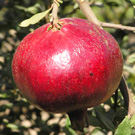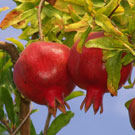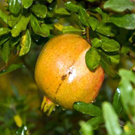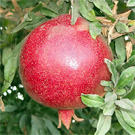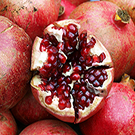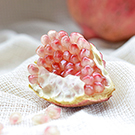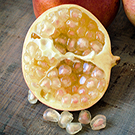The Pomegranate tree is native to ancient Persia and was cultivated over the whole Mediterranean region since the beginning of written history. The tree was brought to California in 1769 by Spanish settlers and has become a wildly popular fruit today. Its popularity is primarily driven by the proven fact of its strong anti-oxidant properties. The rich, tart, unique flavor is also fueling the high demand and is a healthy ingredient to many of the new juice mixes found in stores.
The Pomegranate tree is native to ancient Persia and was cultivated over the whole Mediterranean region since the beginning of written history. The tree was brought to California in 1769 by Spanish settlers and has become a wildly popular fruit today. Its popularity is primarily driven by the proven fact of its strong anti-oxidant properties. The rich, tart, unique flavor is also fueling the high demand and is a healthy ingredient to many of the new juice mixes found in stores.
The pomegranate is a round shaped shrub or small tree that can grow to 20 or 30 feet, but most often it tops out at 12-15 feet in height. The trees are self-fruitful, long-lived, and very productive. They produce best in a hot sunny location and only require 150-200 chill hours. The soil can vary, but must be well-drained. The pomegranate trees will grow well in alkaline soils that would kill most plants. They are cold hardy through Zone 7. Willis Orchard Company offers the six top varieties of pomegranate trees for sale to add to your home orchard.
The botanical name for the pomegranate is Punica Granatum and is a fruit producing deciduous small tree or shrub that can grow between 15 to 30 feet. The pomegranate has many thorny branches with long glossy, narrow and oblong leaves. The fruiting pomegranate has a beautiful reddish orange flower that is trumpet shaped with 3 to 7 petals. The flower is known to turn more orange as it fades and turns into a fruit.
The pomegranate fruit is actually a berry but has the size of a large lemon and grapefruit. The fruit has a mored rounded shape in appearance with thick skin. Depending on variety, pomegranate plants can grow between 10 and 15 feet tall and have an equal spread. The inside of the pomegranate has from 200 to 1400 seeds. Each seed is encased with a water ladened pulp called the sarcotesta. The sarcotesta is edible and will range in color from deep red, red, orange, purple and white. The seeds are safely embedded in a thick, white, spongy membrane that is similar to the inside of citrus.
Cold Hardy Pomegranates
Russian Pomegranates originate in the southwestern and south central areas of Russia as well as former Soviet Republic states such as Kazakhstan, Uzbekistan, Turkmenistan, Kyrgzstan, & Tajikistan. These Pomegranate trees are much more cold hardy than their American variants and can withstand zones 6-10. Flowers and fruit are typically set at a young age. Depending on variety, they can grow between 10 and 15 feet tall and have an equal spread. They prefer full sun and adapt well to any soil type as long as it is well-drained. Russian Pomegranate trees make for a great beginner tree due to their high disease and pest resistance. They have reddish-orange flowers that are bell-shaped and appear on new growth during the spring & summer. Prune them lightly each year to encourage the growth of more fruiting spurs.

